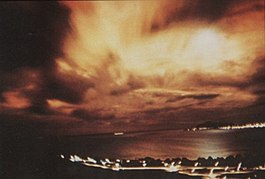Starfish_Prime_aurora_from_Honolulu_1.jpg

Part 1 of 2 Parts
“Starfish Prime was a high-altitude nuclear test conducted by the United States, a joint effort of the Atomic Energy Commission (AEC) and the Defense Atomic Support Agency. It was launched from Johnston Atoll on July 9, 1962, and was the largest nuclear test conducted in outer space, and one of five conducted by the US in space.
A Thor rocket carrying a W49 thermonuclear warhead (designed at Los Alamos Scientific Laboratory) and a Mk. 2 reentry vehicle was launched from Johnston Atoll in the Pacific Ocean, about 900 miles (1,450 km) west-southwest of Hawaii. The explosion took place at an altitude of 250 miles (400 km), above a point 19 miles (31 km) southwest of Johnston Atoll. It had a yield of 1.4 Mt (5.9 PJ). The explosion was about 10° above the horizon as seen from Hawaii, at 11 pm Hawaii time.
The Starfish test was one of five high-altitude tests grouped together as Operation Fishbowl within the larger Operation Dominic, a series of tests in 1962 begun in response to the Soviet announcement on August 30, 1961, that they would end a three-year moratorium on testing.” Wikipedia
The effects of the Starfish Prime test were far more devastating than the Pentagon had estimated. It brought about a treaty that banned the deployment of nuclear weapons in space. In an instant, an electromagnetic pulse (EMP) knocked out hundreds of streetlights in Hawaii, some 900 miles away.
However, it was in space where the most powerful effects were felt. Within minutes of the detonation, the blast had created a fire ball and a glowing red aurora was clearly visible to observers hundreds of miles below.
Unexpectedly, energetic electrons released during the high-altitude nuclear blast became trapped by the Earth’s magnetic field. They formed radiation belts that lingered for several months after the detonation. As they travelled around the planet, these electrons destroyed or damaged one third of all satellites in low orbit at the time. This destruction included some satellites that were located on the other side of the Earth. Among the satellites damaged was the UK’s first orbital satellite, Ariel One.
It is partly the result of Starfish Prime that has driven the current alarm at reports that Russia is developing a new space-based anti-satellite (ASAT) weapon. Insiders familiar with the classified information state that the weapon system is still under development and has not been deployed in orbit. The Russian ASAT is said to include a nuclear component.
The precise nature of this nuclear component remains uncertain at this time. Two prevailing theories suggest that the Russia ASAT contains either a nuclear warhead or a nuclear-power system.
The possibility of a nuclear-armed anti-satellite weapon raises questions as to what it could be used for militarily. Russia has demonstrated in the past its capability to conduct conventional strikes against satellites with ASATs. In November 2021, Moscow was widely condemned for carrying out a conventional ASAT test. It produced so much space debris that it posed a temporary threat to the International Space Station.
Please read Part 2 next